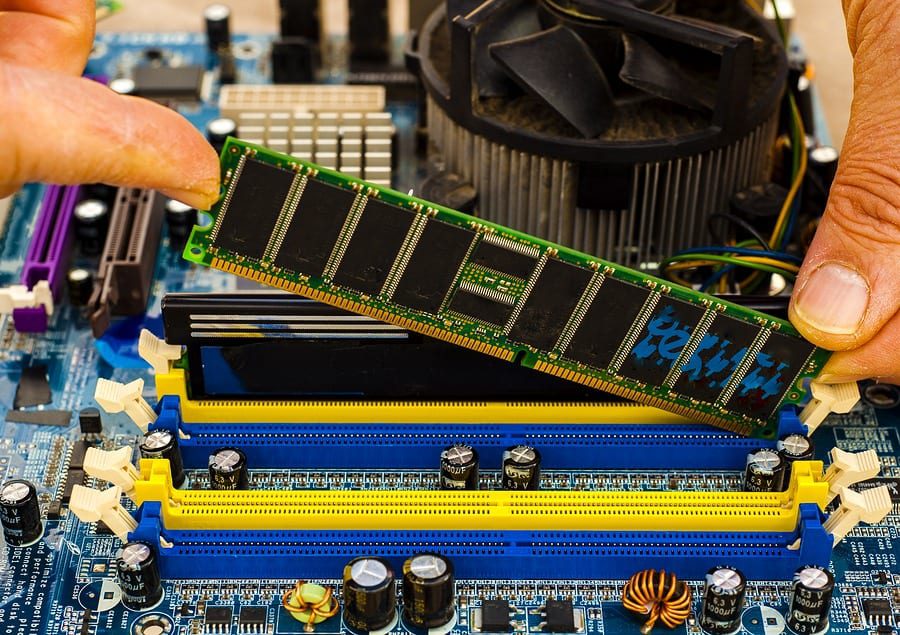Slot Memory Ram
When a user wants to add or upgrade memory (RAM) in a computer, they need to know how many memory slots are available. The following section helps you to determine the number of memory slots in your computer, and how many are used.
- This page describes the RAM specifications for many of the MacBook laptops. In the section for my laptop (13″ Pro, Late 2011), it says: Additional Notes: For best performance, fill both memory slots, installing an equal memory module in each slot.
- Slots This is the total number of memory upgrade slots (sockets) followed by their configuration. Banks are the way a system addresses memory. A bank must be completely filled with memory modules of the same size and type in order for the system to recognize and address the memory.
- With equal amounts of memory in both slots, memory can be interleaved so that successive chunks of memory alternate slots. That way, memory access gets distributed to both slots almost perfectly evenly, allowing their bandwidth to combine. With uneven amounts, memory cannot be interleaved and has to be mapped first to one stick and then the other.
Windows Task Manager
The easiest solution for Windows users is to open the Windows Task Manager.
It normally shows information similar to Slots used: 1 of 2, which indicates 1 RAM slot is used out of 2 available, making 1 free RAM slot available. The information on RAM memory slots in Task Manager is not always foolproof and correct though, especially with computer that has soldered memory to motherboard.
- Press the Windows key, type Task Manager, and then press Enter.
- In the window that appears, click the Performance tab (A), then select Memory (B).
- In the lower-right corner, the number of slots is displayed in the Slots used: section (C).
- As you can see, this computer has a total of four memory slots, although only two are currently being utilized.
Use the CPU-Z utility
Another way to get information about memory slots and details about the RAM currently installed on your computer, is to use the free CPU-Z third-party utility.
- Open an Internet browser and visit the CPUID website.
- On the left side of the screen, select your operating system.
- On the next page, select your preferred language.
- On the next screen, click the DOWNLOAD NOW! button.
Slot Memory Ram Ddr3
- Once the download has finished, install it from your browser and open the program.
- Click the SPD tab at the top of the screen, and then click the down arrow in the Memory Slot Selection section.
- As you can see in the image above, all of the memory slots are listed on the drop-down menu.
If you select a different slot from the drop-down menu, CPU-Z will tell you additional information about the RAM that is installed.
Examine the motherboard

Sometimes the best way to determine the available memory slots is to open the computer and examine the motherboard. Opening the computer is the best option if were unable to get the Windows Task Manager or CPU-Z to work.
Looking inside the case, the motherboard is the primary large circuit board. On most motherboards, the memory slots are on either side of the CPU, and resemble what is shown below.
Most computer motherboards have two, three, or four memory slots. Some higher-end motherboards have as many as eight. The above motherboard picture above has no memory modules installed in any of its three slots.
NoteIf your computer has no memory slots available and you want to upgrade, you must remove and replace some of the existing memory.
Additional information
- See our memory definition for further information and related links.
Slots
This is the total number of memory upgrade slots (sockets) followed by their configuration. Banks are the way a system addresses memory. A bank must be completely filled with memory modules of the same size and type in order for the system to recognize and address the memory. i.e. :
3 (3 banks of 1) This indicates that there are 3 memory slots. These are divided into 3 banks, and each bank consists of one memory slot. So you can add memory one piece at a time for the system to use.
Memory Slot Not Reading Ram
4 (2 banks of 2) This indicates that there are 4 memory slots. These are divided into 2 banks, and each bank consists of two memory slots. So you must add memory two pieces at a time (they must be the same size and type of memory) in order for the system to benefit from the upgrade.
12 (3 banks of 4) This indicates that there are 12 memory slots. These are divided into 3 banks, and each bank consists of four memory slots. So you must add memory four pieces at a time (and they must be the same size and type of memory) in order for the system to benefit from the upgrade.